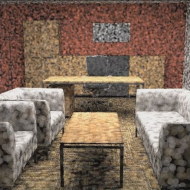 |
Jaroslav Křivánek |
Toward Evaluating Progressive Rendering Methods in Appearance Design Tasks
IEEE Computer Graphics and Applications (accepted for publication)
|
Jiawei Ou
Dartmouth College |
Ondřej Karlík
Charles University, Prague |
Jaroslav Křivánek
Charles University, Prague |
Fabio Pellacini
Dartmouth College & Sapienza University of Rome |
 |
 |
 |
 |
| Random path tracing | Quasi-random path tracing | Progressive photon mapping | Virtual point lights (Instant radiosity) |
Example images generated by the algorithms compared in our study. (Compare larger images in individual tabs.)
Abstract
Progressive rendering is becoming a popular alternative to precomputation approaches for appearance design tasks. Images created by different progressive algorithms exhibit various kinds of visual artifacts at the early stages of computation. We present a user study that investigates the effects of these artifacts on user performance in appearance design tasks. Specifically, we ask both novice and expert subjects to perform lighting and material editing tasks with the following algorithms: random path tracing, quasi-random path tracing, progressive photon mapping, and virtual point light (VPL) rendering. The experimental result suggests that path tracing is strongly preferred to progressive photon mapping and VPL rendering by both experts and novices. There is no indication that quasi-random path tracing is systematically preferred to random path tracing or vice-versa; the same holds between progressive photon mapping and VPL rendering. Interestingly, we did not observe any significant difference in user workflow for the different algorithms.
Publication
Jiawei Ou, Ondřej Karlík, Jaroslav Křivánek, and Fabio Pellacini. Toward Evaluating Progressive Rendering Methods in Appearance Design Tasks. IEEE Computer Graphics and Applications (accepted for publication) ... DOI | BibTeX
Downloads
| paper |
supplemental documents |
video |
 |
 |
 |
| 3.6MB pdf | 36MB zip | 77MB mov |